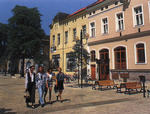
The district city of Breclav lies in the country chosen by the first Slavs, who came from the area of East Danubia in the 6
th century.
Southeast of today's city, an extensive locality featuring developed trading was established at the end of the 8
th century, and during the Great Moravian Empire in the 9
th century it became one of the fortresses of the central Great Moravian territory. The fortress was destroyed at the beginning of the 10
th century and the region was the setting of battles for
the heritage of the Great Moravian Empire, finally won by the Czech Premyslids.
The new castle, named after Prince Bretislav, was to protect the border of the country, and was located where Breclav Castle stands today. This castle was probably established after 1041, and became the center of administration. At the beginning of the 13
th century it was given to Constantia of Hungary, the wife of the Czech king Premysl I., as dowry. In 1654 the Breclav estate was purchased by the Lichtensteins and added to the other lands of this family, Valtice and Legnice.

At the end of the 18
th century, the Lichtensteins altered the area of Breclav with a romantic landscaping design. They successfully combined economic and aesthetic functions, and they planted forests, among which there are a number of exotic trees.
They also built minor structures of a romantic character in Empire and Classical styles, and since the beginning of the 19
th century structures in the English New Gothic style were also built. Famous architects such as Hardtmuth, Kornhausel and Engel sought inspiration in antiquity, the orient, and high medieval style, and they revived this romantic wooded country with a number of minor structures such as the classical chateaus of Pohansko, Hranicni and Rybnicni; the Reistna colonnade; the romantic structures of Janohrad; a Roman aquaduct, etc. However, the most significant New Gothic structure is the chateau of Lednice, which was rebuilt from the formerly Baroque chateau by Josef Wingelmuller between 1846-1848.
In 1872 Breclav was raised by decree of the emperor to the status of city. Following the arrival of the first train from Vienna, Breclav became the first railway hub of the Austrian Empire, since the routes divided here, one to Brno and the other to Olomouc. Later, routes to Znojmo, Lednice and Bratislava were added.



 Guide
Guide 





